Panels for the bathroom: features, varieties and tips for choosing

Anyone who does not want to make a protracted and expensive renovation in the bathroom with the participation of tiles can turn their attention to such a type of cladding as panels. Different types of materials are involved in their production, and they determine the final cost and appearance of the product.
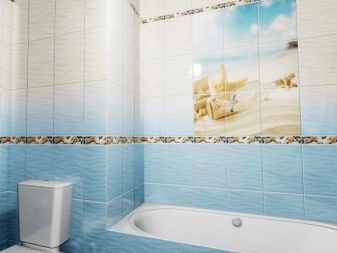
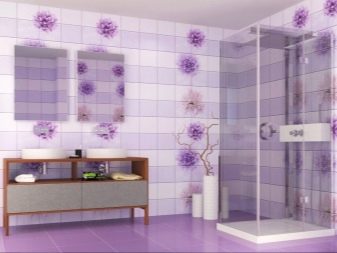
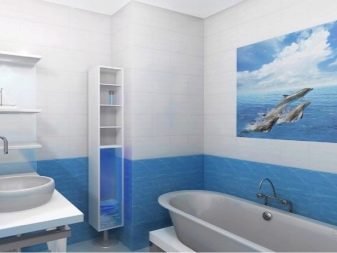
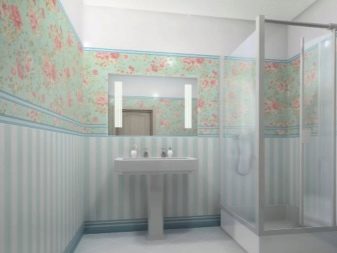
Peculiarities
The bathroom is extremely demanding on the facing material. In conditions of high humidity, not every product can survive for a long time. That's why the main feature of the panels will be their waterproof properties... The second feature is the size of the products, which is significantly superior to ceramic tiles. For example, slatted panels can be up to six meters in length.
The large dimensions facilitate installation, which is why they are often used in public spaces with large spaces. The third feature is seamless installation. Moisture does not penetrate the seams and does not cause mold and mildew.

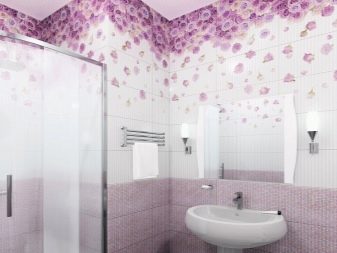
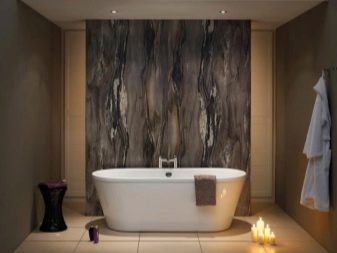
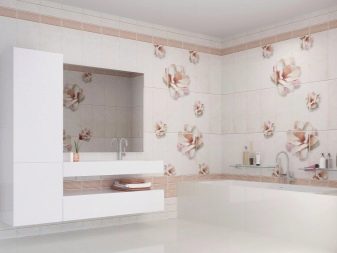
Panels are made from different materials. No one doubts that glass and plastic do not allow water to pass through. And what about the chipboard, fiberboard, MDF panels? A feature of these products, designed for places with high humidity, are special components and gluing impregnations that are added to the wood-based material... An important role is played by the lamination of the panel surfaces.

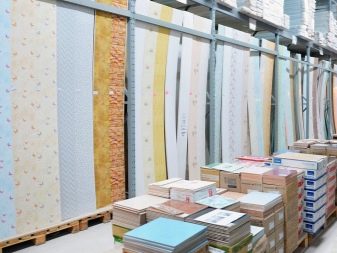
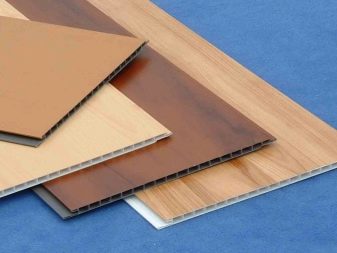
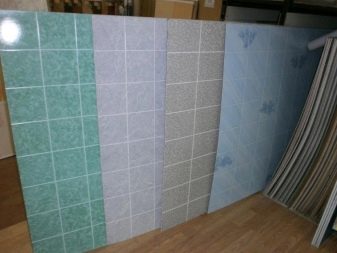
Advantages and disadvantages
Bathroom panels are gaining more and more popularity. To please the buyer, the industry has mastered the production of these products from many materials.It would be correct to consider the advantages and disadvantages of each option separately, which we will do in the future, but for now we will try to figure it out. what are the panels attractive in general and why they can be preferred to other finishing materials:
- they are easy to install and handle;
- they look great;
- have waterproof and thermal insulation characteristics;
- many of them are shockproof, endowed with high strength;
- are distinguished by a wide variety of materials, shapes, textures and color palette;
- have a moderate cost, which distinguishes them favorably from ceramic tiles;
- behind the slats, you can hide electrical wiring and pipes;
- the worn-out panel can be easily dismantled and replaced with a new one.
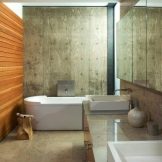
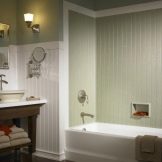
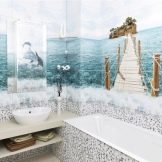
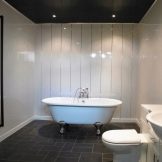
It would be more correct to judge the shortcomings by considering each material separately, for example, some types of plastic can be mechanically damaged, and wood products are afraid of moisture.
But there are many options that have successfully overcome all these negative moments, and thanks to them you can always find the perfect panels for your bathroom.
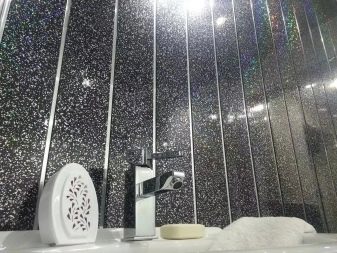
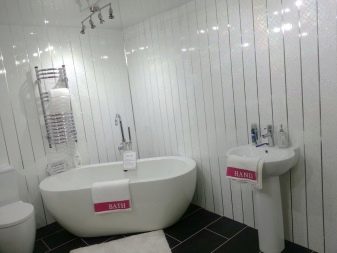
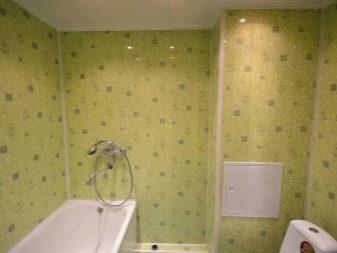
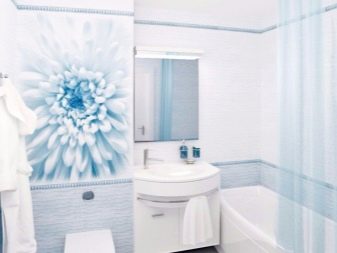
Requirements
The bathroom is the dampest room in the apartment. Water and hot vapors are becoming a big test for cladding materials. If the process of destruction of the finish has begun, in conditions of high humidity it will proceed at an accelerated rate. There are a number of requirements that wall panels must meet:
- have increased moisture resistance;
- be resistant to temperature extremes;
- respond well to household chemicals;
- a big plus if the material contains antifungal and antimicrobial additives;
- for a stable appearance, panels need a stable color that will not fade with time and hot steam.

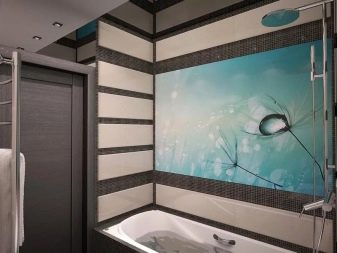
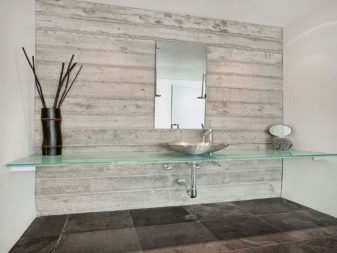
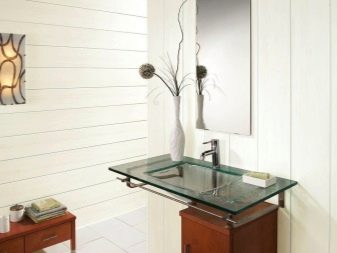
Which is better: panels or tiles?
A noticeable difference between these cladding materials is 4 points:
- the difference in the area of \ u200b \ u200bproducts;
- most panels are cheaper than ceramics;
- installation of panels is faster and easier than tiles;
- the tile outweighs its opponent.
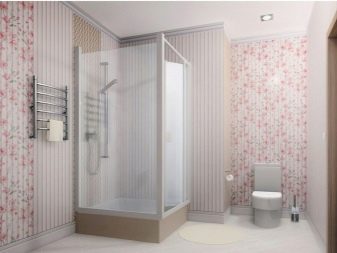
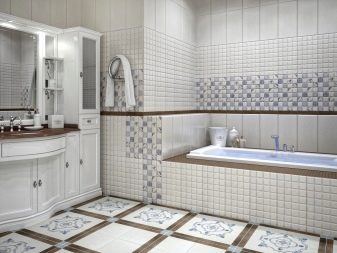
It is impossible to give an unambiguous assessment of the two types of finishes, since the panels are represented by different types of materials. But you can compare ceramics, for example, with PVC products, which are most popular due to their low cost and speed of installation.
Let's start with what they have in common:
- both materials are moisture resistant;
- respond well to household chemicals and are easy to clean;
- have a large selection of colors and patterns.
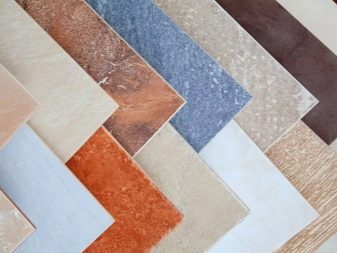
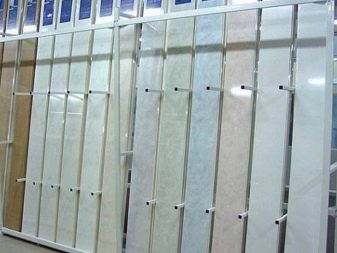
There are many differences between ceramic tiles and PVC panels.
- The strength of the tile is significantly superior to that of plastic, which affects its durability.
- PVC can be installed on side walls, ceilings, protrusions and niches. With this material, it is easy to hide pipes and electrical wiring. Only the walls and the floor are tiled.
- Locks at the joints of plastic panels allow them to be mounted without gaps, which completely excludes moisture ingress. The tiles are laid out with seams. If they are processed in violation of technology, water can get under the cladding and lead to the growth of bacteria.
- For the installation of tiles, the walls are ideally aligned. The panels do not require such preparation; they are installed on a previously drawn frame.
- Working with tiles is more laborious, messy and requires skill. Installation of PVC panels can be done independently. There is almost no dirt left after it.
- Decorating a bathroom with plastic panels will be much cheaper than using tiles, but the operation of such a room will be less durable.
- Sand and clay are involved in the production of ceramics; they are classified as environmentally friendly materials. Plastic cannot boast of being natural.


Views
A large selection of bathroom panels helps to solve various problems: to disguise plumbing pipes, make repairs quickly and inexpensively, or create an original design that you will not find in any of your friends. To understand the abundance of panels offered by manufacturers, we will consider all their types in turn. First, let's select 3 large groups: inlaid rack, inlaid tile and sheet panels.

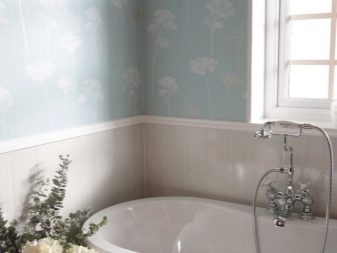
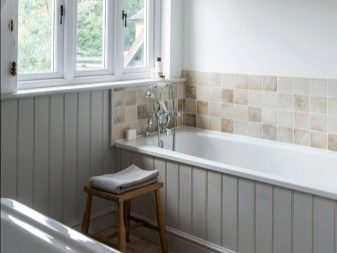
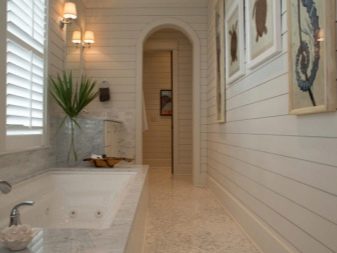
Rack panels
Most often they are installed on ceilings, but sometimes they are also revetted on walls. Such panels do not allow water to pass through, have good soundproofing, fireproof and frost-resistant properties. The rack background is perfectly illuminated by built-in lamps. Panels made of type-setting slats are presented in different sizes, but the most popular slats are 10 cm wide and from 3 to 4 meters long, although you can find products up to 5.9 meters on sale.
The industry produces sprayed plastic, aluminum and metal products. The edges of the slats, bent in a special way, form a docking lock, thanks to which you can independently, easily and quickly carry out installation work even on a curved wall. When installing a slatted ceiling, it should be remembered that the height of the room will decrease to 15 cm.
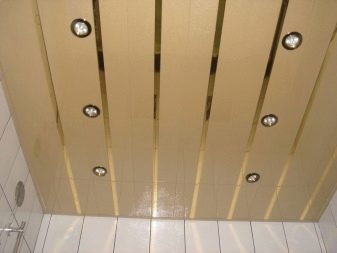

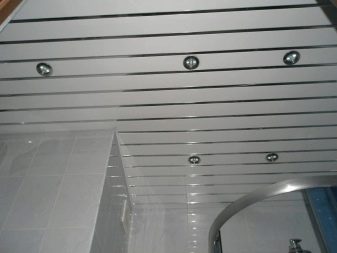
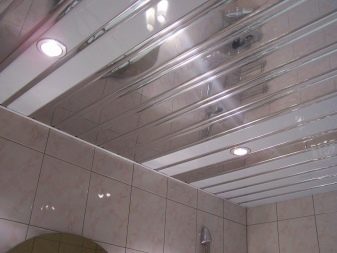
Tiled panels
Tiled panels are available in square or rectangular shapes and do not have standard sizes. Numerous collections can have their own parameters. In appearance, tiled panels are difficult to distinguish from real tiles, they retain the beauty of ceramics and its water-repellent properties, but at the same time they are much easier to install and are cheaper. Products do not have locks, therefore, when working with this material, you need to properly track the joints.
If they did not succeed, it is quite permissible to close the errors with overhead strips, but they will have to be prepared in advance.
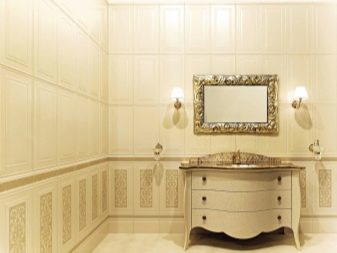
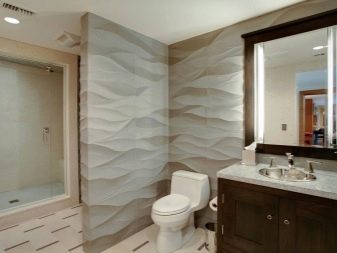

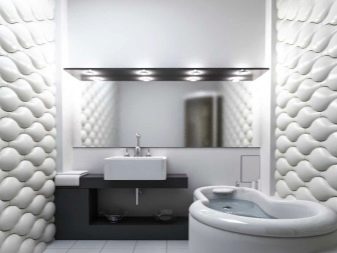
Sheet panels
They are made of different types of material - plastic, MDF, chipboard, have water-repellent properties, a large selection of textures, patterns and colors, presented in both matte and glossy versions. Sheet panels perfectly imitate various materials - ceramics, wood, stone, mosaic.
The standard dimensions are 122x244 cm, but there are other numerical indicators. Large parameters allow for quick installation, especially owners of spacious bathrooms can appreciate this. The absence of docking locks implies sealing the seams with moldings or special strips.
The variety of facing panels is provided by different types of materials for their manufacture. While they are all designed for the bathroom, the difference in performance and appearance is obvious. To be sure of this, you need to consider each species separately.
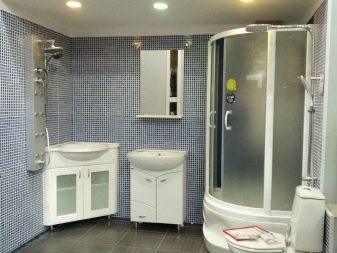


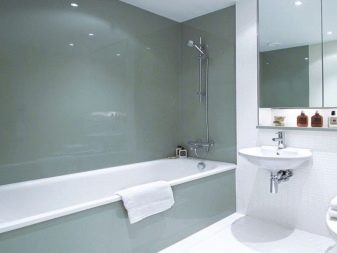
Plastic
Plastic panels are made from polyvinyl chloride (PVC). Petroleum products and salt elements are transformed into a super-strong polymer using modern technologies, and special additives provide an abundance of color. The resulting material is not toxic, it is moisture resistant, so it can be used to perfectly decorate the bathroom.
Panels differ not only in color and pattern, they can be seam and seamless, have a matte or glossy surface, the image itself is applied by film or by printing.
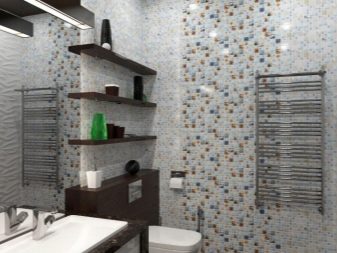
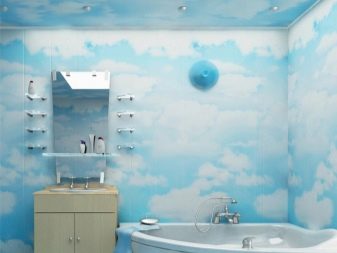


Plastic sheathing is popular for its wide variety of colors and patterns. They are easy to install and inexpensive. Those who decide to make budget repairs in their bathroom at an accelerated pace will choose plastic sheet panels. The positive properties of the material include good thermal insulation and soundproof qualities. Installation is carried out in several ways.
- A frame is pre-installed on which plastic panels are mounted. This method will help to obtain additional sound insulation, hide rough wall drops, and hide communications.
- The second method involves fixing the panels directly to the wall.... It is important that their surface is dry, clean and does not have any noticeable differences. All small roughness and irregularities are easily hidden behind the plastic layer.
In addition to a lot of advantages, plastic also has disadvantages. It is damaged upon impact, dangerous during a fire, deforms at low temperatures (from -20 degrees), and burns out in the sun. But most of the disadvantages do not relate to his stay in the bathroom.
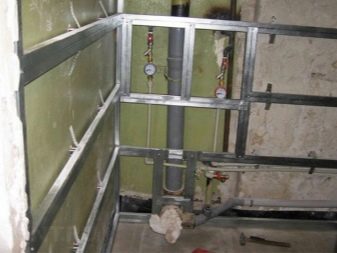
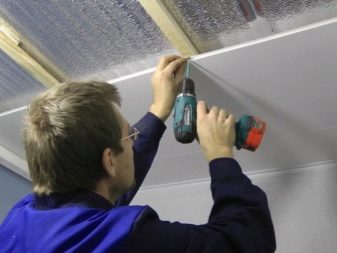
MDF
Finely dispersed dry shavings are involved in the production of MDF. It is pressed under high pressure using high temperature. The material is much denser than fiberboard. The polymer coating over the pattern allows the use of MDF panels in rooms with high humidity, even in shower cabins, which is confirmed by the image of a drop on their packaging.
Such material, in addition to imitating wood, can look like ceramic tiles, marble, onyx and other surfaces. It is so durable that you can mount hanging furniture on it. MDF panels meet all the requirements that are installed for bathrooms: they are moisture resistant, unpretentious to maintain, dampen sound, retain heat. They are installed as easily as PVC, on walls with any irregularities.
It is better to coat all seams with a transparent sealant, it will enhance the water-repellent properties of the cladding. Under the frame, you can hide wiring and pipes, but it should be remembered that part of the area will be lost due to the massiveness of the finishing material.
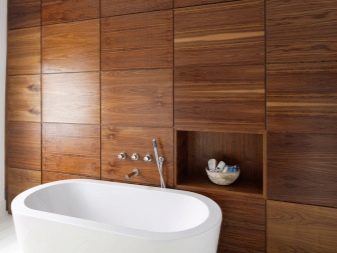
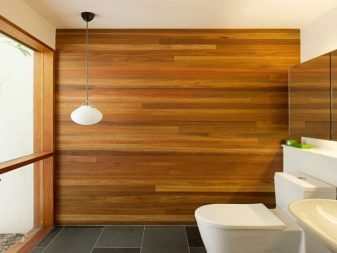
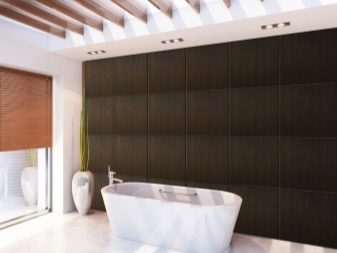

Fiberboard
Fiberboards are inferior in density to the previous material, although they are produced using the same technology. The difference lies in the content of larger fractions of wood fibers. This affects moisture resistance. Panels may swell over time if they come into direct contact with water. Special impregnations help to increase resistance to moisture. Especially well proven products with the addition of bitumen. They are called hardboard panels. They are covered with a laminating layer to protect the material from water and mechanical damage.

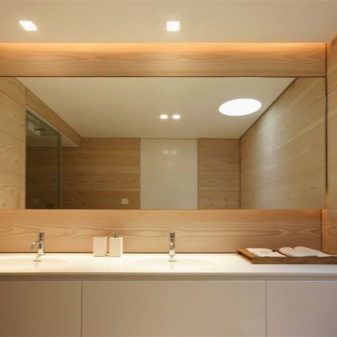
Chipboard
Panels made of this material are vulnerable to liquid ingress, since it contains even larger fragments of wood - shavings, sawdust, wood chips. To make such a product moisture resistant, binder mixtures are used for its production, and the surface is laminated. Particleboard can be used in large bathrooms, where it is possible to place them away from sources of water and hot vapors. It is better to install more moisture resistant material in the working area.
Chipboard wall panels withstand the load well; it is permissible to mount furniture on them. They have sufficient resistance to mechanical stress, just like the materials described above, they can imitate ceramics, stone and wood.
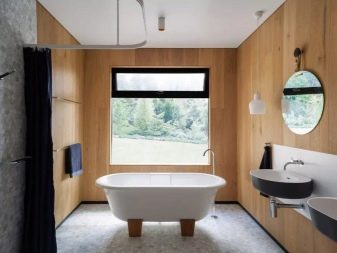
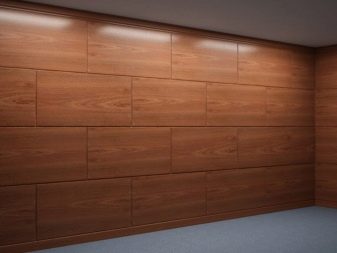
Glass
Glass panels add originality to the bathroom interior. They are rarely used in design. They are specific to styles fusion, hi-tech, techno, minimalism, modern. Despite the fragility of the material, with a careful attitude, it will last a long time, since the glass does not actually wear out. Such panels, due to the rarity of use, can be called unique. They work to expand the space and look spectacular. Plumbing pipes can be successfully hidden behind matte and colored canvases.
The disadvantages of glass panels include their fragility, high weight, injury risk in the event of their destruction, complexity of installation and high cost. Glass needs frequent maintenance, as streaks and stains remain on its surface even from ordinary water.
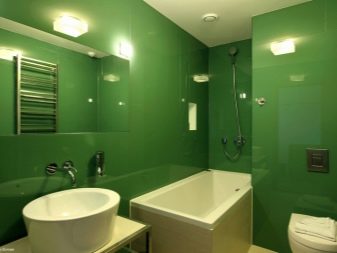
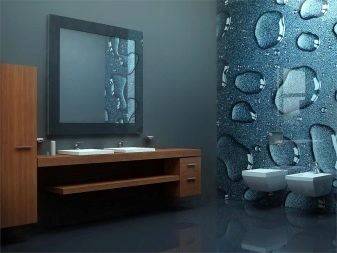
Acrylic
Modern innovative material for surface cladding. It has a variety of colors. Acrylic has surpassed PVC, MDF and even ceramic tiles in terms of price. But this is its only drawback. It has incredible strength, impact and abrasion resistance. He is not afraid of ultraviolet light and problems with flooding.
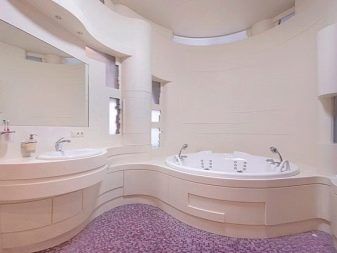
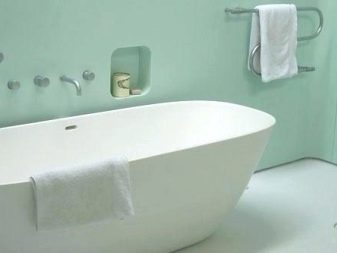
Mosaic
Mosaic panels can decorate the interior in an amazing way. Most often they are presented in an abstract version, but they can also contain a plot drawing, which is skillfully used by designers. The industry presents a large selection of their color palette. The mosaic is beautiful, environmentally friendly, durable, it is not difficult to install such panels.
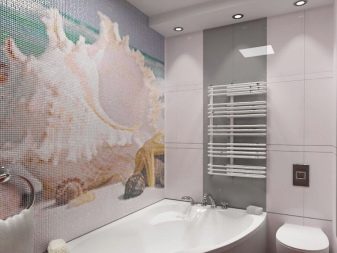
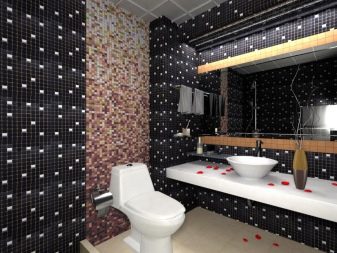
Aquapanels
The product consists of lightweight expanded clay, covered with fiberglass mesh. Ideal for the bathroom, as they are moisture-repellent and resistant to temperature extremes. Outwardly, the aquapanel looks great, it is elastic, bends well, it is easy to care for it. Attach the product to the frame using special glue and screws.
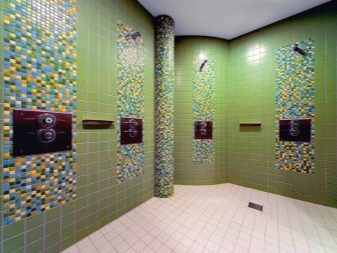
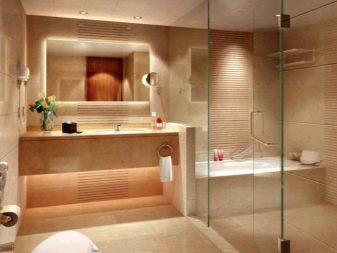
Design options
Facing panels are able not only to fulfill the functions assigned to them - to protect walls and ceilings from moisture and hot vapors. They can create gorgeous interiors that fit different styles. The panels have all the possibilities for this.
- Rough wood-look slatted panels are great for style country.

- Glass cladding meets ideas minimalism or hi-tech.
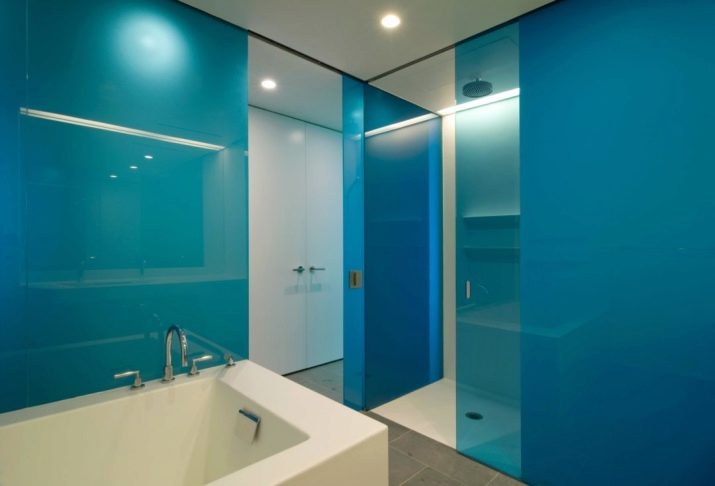
- Bathroom in style modern it is made out with the participation of slatted panels that imitate wood.
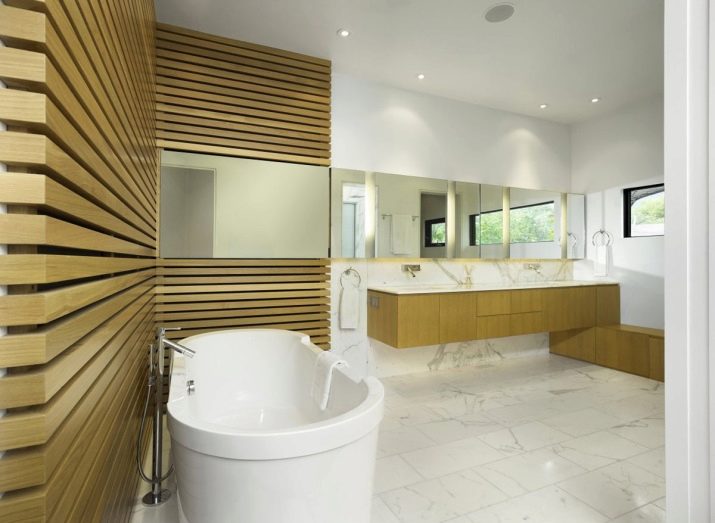
- Bathroom panels in style provence.
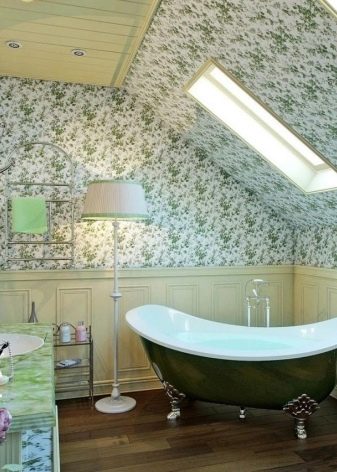
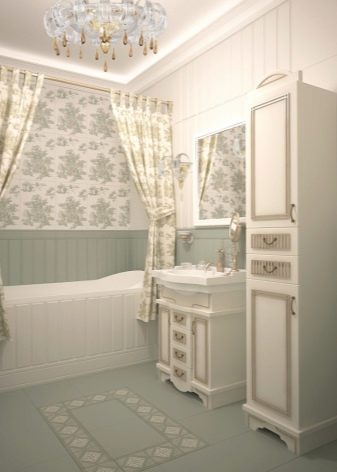
- Panels in the form of mosaic inserts in the Moroccan style.
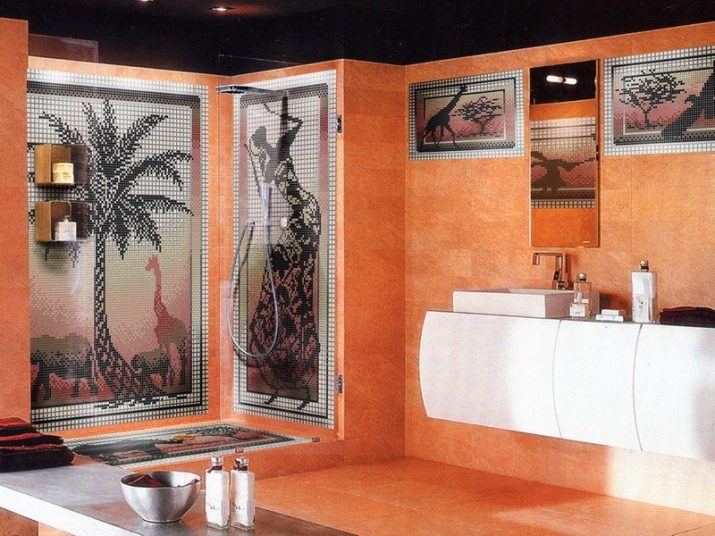
How to choose?
Choosing between different types of panel products, you need to decide for yourself what you specifically want from the cladding and what budget you are counting on.
If you need a quick and low-cost repair, PVC panels are the best choice, according to reviews.... They are assembled independently, without helpers, they are easily cut with a knife and leave almost no debris. But you should pay attention to the models of the higher class, in which the thickness is at least 7-8 mm, then it will be possible to operate the bathroom with them without special care.
If the budget is unlimited and the task is to surprise your friends, you may prefer glass or water panels. Art mosaics are also suitable.
Acrylic panels are chosen as a modern, strong and durable material.
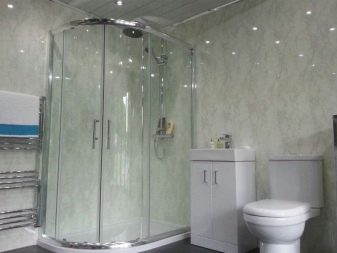

When a particular option is given preference, attention should be paid to the quality of the product. It is imperative to inspect the product from the end - it must have a clear, even edge, without bends and deformations. Then you need to pay attention to the locks - if they begin to break when bending, then the product is not reliable.
An unpleasant smell from plastic panels speaks of the use of low-quality material in their production. The same happens with laminated chipboard products. A pungent odor is betrayed by the presence of toxic impregnations. The negative manifestations will intensify with an increase in ambient temperature, which often occurs in a bathroom. In this case, you can ask the seller product certificate, which should indicate harmful additives in its composition.
When choosing panels from chipboard and MDF, you need to pay attention to the presence of icons indicating moisture resistance, otherwise you can mistakenly purchase products for use in dry rooms.
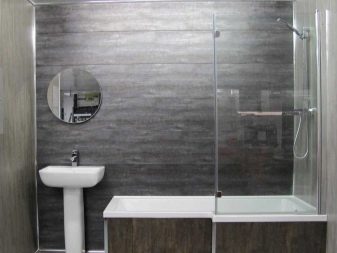
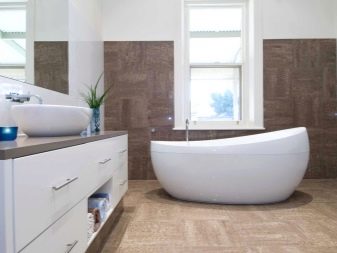
Beautiful examples
Sometimes it is difficult to know which wall panels are best for a bathroom: vinyl, decorative, sliding glass or false panels. Those who doubt their choice can view a selection of beautiful interiors created on the basis of waterproof panels.
- An unusual stylish bathroom can be made from simple plastic panels.
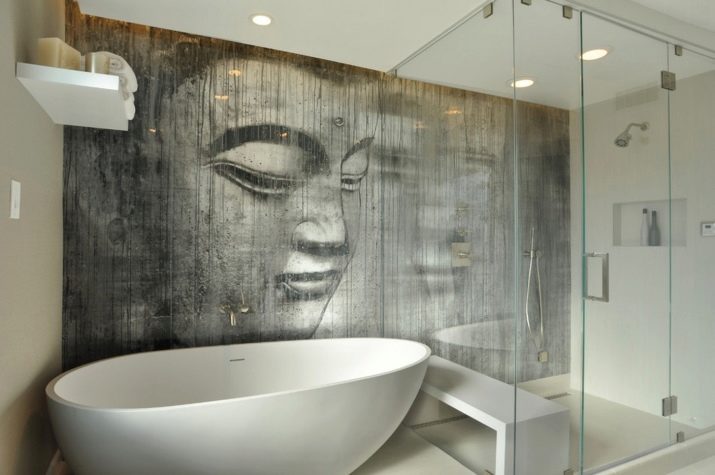
- The Japanese-style interior panels created a full-wall artistic image.
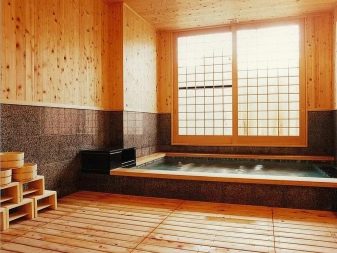

- Combination of mosaic and mirror panels in the bathroom.
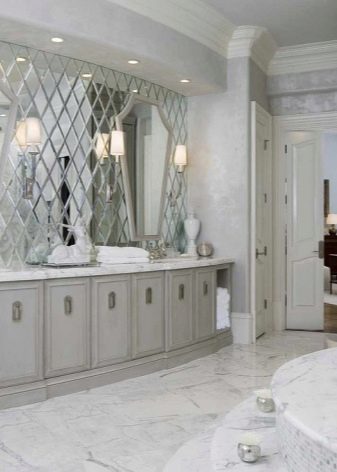
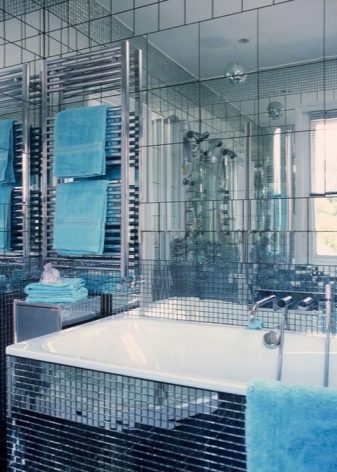
- Monochrome mosaic cladding.

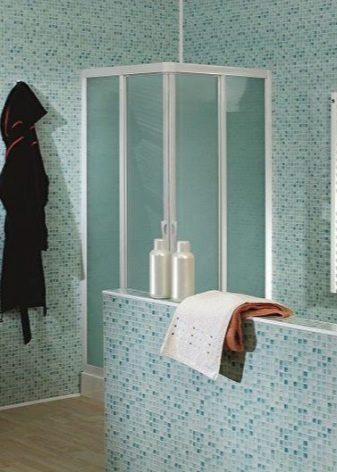
- With the help of 3D drawing, a collection was created as if from the future.
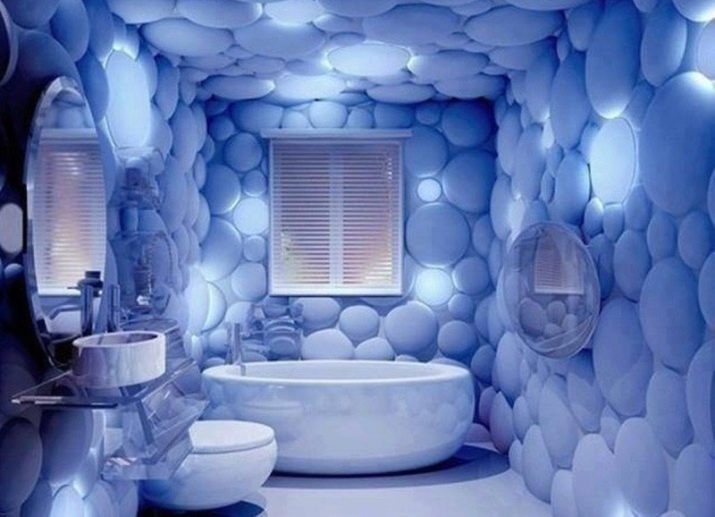
- Plastic imitating artificial stone.
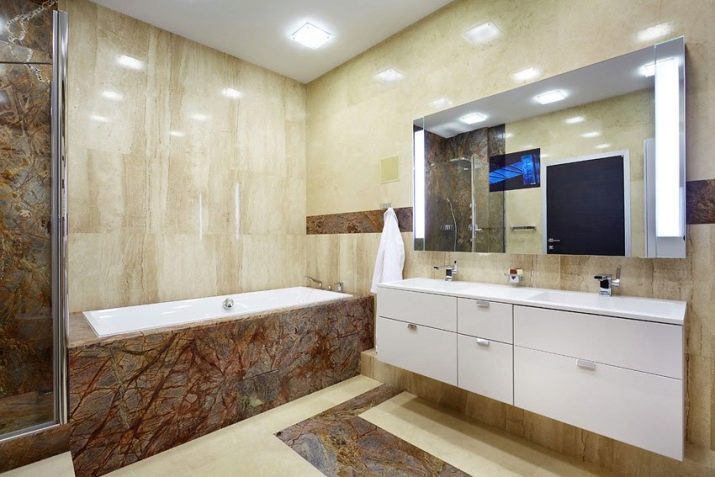
- Hardboard panels. Panels for the bathroom will help to arrange any design in it and become a reliable, durable interior decoration.
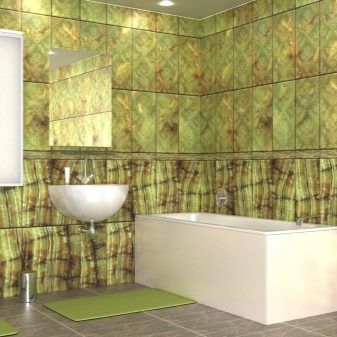
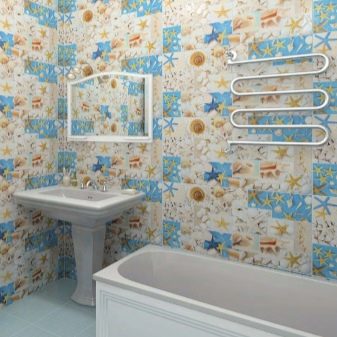
In the video, you will learn the secrets of choosing PVC panels for the bathroom.








